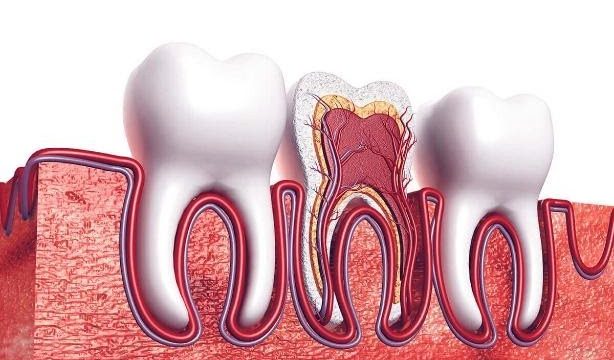
Let us just get straight into this. What is a root canal treatment? Well, first you need to know a bit more about tooth structure.
Teeth are mainly made from a hard material known as dentine. Then there is the surface layer, which is enamel. It is there to protect the parts of the teeth you can see, also known as the crown. Pretty much all the tooth that you cannot see, or below the gum line, is referred to as the root.
The root is what anchors your teeth into your gum and jaw. Commonly your front teeth just have the one root, while molars will have up to three roots. Inside the root section of your teeth, there can be multiple root canal spaces.
Your tooth also has a “hollow” centre, which can also be called the pulp chamber. Inside this chamber there are blood vessels, nerves, and pulp. It is the pulp that provides life to the teeth, and it carries oxygen, nutrients and is why you have feeling in your teeth. This pulp is in the main chamber, and it also extends down into the various root canals within your teeth.
That Is the End of The Science Lesson…
Now you understand the tooth structure, a root canal procedure is what is often required when a root canal is breached. This usually is because of decay and that becomes infected. If any part of the root pulp in any root canal is infected by germs, then the whole area must be disinfected.
This is what happens during a root canal treatment.
Symptoms Of Tooth Pulp Infection
There are many symptoms of tooth pulp infection. They include:
- unexplained spontaneous pain
- sensitivity to hot and cold drinks
- pain when biting or chewing foods
- teeth loosening
- gum swelling or other gum issues like inflammation
There are also times when there might not be any noticeable symptoms, but the infection or damage can be seen on a dental x-ray.
Reasons For Root Canal Treatments
The main problems that can occur if the presence of tooth pulp infection is not taken care of can include more serious issues such as
- the infection can spread to other areas of your tooth
- localised bone loss, including jawbone damage in severe cases
- loss of the tooth, usually by extraction by a dentist
What About the Health of My Tooth After a Root Canal Procedure?
To solve this dental issue, your dentist must complete a few steps. Firstly, removing the decay and infection. The previously infected canal then needs to be shaped and filled to prevent the return of infection to the area (Conci). They must then seal the tooth and ensure it is functional again, your dentist may suggest placing a crown on the root canaled tooth for example. There is a possibility of other damage to the tooth too, caused by previous infection or decay that should also be taken care of during this part of the procedure.
Removing the pulp and resealing the tooth as described, does not “kill” the tooth as is sometimes wrongly believed by some people.
The main function of the pulp, which is removed, is to regulate the growth and development of your teeth when you are a child. After this is done and you have adult teeth, they are nourished by tissue surrounding the root, not the pulp itself.
Therefore, a tooth can function normally in most cases without the pulp. It can be kept indefinitely after a root canal and can function like any other tooth in your mouth.
One issue that can arise long term after a root canal, is that the tooth can turn a little greyer than your other teeth. This can also be managed by most dentists. Most root canal procedures are performed on the back molars, so they are not your most visible teeth.
If you have any questions about root canal treatments or any other dental procedure, especially if you feel anxious about it, then simply contact us to learn more about it.
